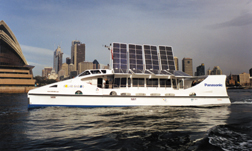 |
| The real thing: Dr. Daneís
dream come true, the solar ferry operating now in Sydney
harbor. |
We had eighty-two days to build
it. The motor was coming from Switzerland and the agent who was
supplying it was also competing in the solar boat race. I suspect
that he was trying to stop me because the motor didnít arrive
until two weeks before the race. We did all our testing with
outboard petrol motors to simulate how the boat was going to go.
It was very stressful. Halfway
along we realize our hobby train guy wasnít going to be able to
put together all the panels in time. We put an ad in the paper and
that got us Max, who had just quit his job with British Aerospace
to become a Buddhist. What he did was elevate us from being just a
doctor and a bunch of surfers to doing this at the next level.
We christened the finished boat
the Marjorie K. in honor of our patron Marjorie Kendall.
Before we had a chance to tell Marjorie, she had a stroke. She was
up in the hospital and doing very poorly. The doctors werenít
sure that she would ever recover. I went to see her and said,
"Weíre called the boat the Marjorie K." Well,
she recovered overnight. Sheís still firing, comes to all of our
functions and still runs the dairy farm.
On the day of the race we
solared, did 6.52 knots the whole race and won by a mile. But half
way around, we hit the Japanese boat and ended up officially
coming in second because we were penalized. All good races are won
in the protest room.
But we had a video of our boat
just scooting along. I got the number of a famous naval architect,
Grahame Parker. I rang him and said, "Weíd love to come and
see you. We just won this solar boat race. " He said,
"Great. Come see me." I said, "Do you reckon itís
going to work on big boats? Will it work or should I go back to
medicine?" He said, "Itíll work."
Within a week heíd done
drawings of a solar version of a boat very similar to the ferry weíve
got running now in Sydney. I used the drawings to go around town
and raise money. We applied for several government grants but didnít
get Ďem. I got a part time job doing drug and alcohol counseling
and the rest of the time I was on the phone trying to raise about
three million dollars.
Then one Christmas, I was at a
party and started talking to this guy, Graham Kelly, the chairman
of a company called Novogem, a pharmaceutical company. Graham was
a veterinary doctor. He said, "Hereís my card. Come and see
me on Monday." This was after more than eighteen months of
trying to raise money.
We started construction in June
of 1999 and, exactly one year later to the day, we sailed the Sydney
Solar Sailor under its own steam in the harbor. Itís being
run now by the number one private ferry operator in Sydney called
Captain Cook Cruises. Itís running as a corporate entertainment,
school educational and excursion boat. It does a highlights
cruises just the ferries do here in San Francisco. It hasnít
missed a single day.
Itís costing Captain Cook
nothing in fuel to run. It probably uses renewable energy about
eighty percent of the time. The other twenty, we burn gas, backup
energy. We get the gas for free because the gas company sponsors
us, ironically enough. Itís BP, which used to be, as everyone
knows, British Petroleum. Now theyíre renamed Beyond
Petroleum. Weíre not using much of their gas, though.
The boat can handle two tons of
batteries. We can put seven tons of passengers on this boat, a
hundred people, and the boat only slows down half a knot. Thatís
why solar ferries and boats are possible. The laws of physics
allow it. You canít put seven tons of batteries and people on a
bus and expect it to go uphill if itís got solar power. The
power to weight ratio is all wrong. The good thing about boats is
that they donít have to go uphill. They donít have to stop and
start in traffic. They go a constant speed.
Iíve learned a lot hanging
around the solar industry these last three years. Itís an
embryonic industry and thereís not much money in it, although BP
is expecting it to be a $2 billion a year industry by 2007.
Yet I know that this will be
the solar century. As a doctor, I feel that itís insane to be
digging these fossil fuels up. What if in three hundred years, we
find that petroleum can be used for something else, like to grow
skin or bones or use it in plastics in some new way, and weíve
burned it all up? Further, when you burn it, you create toxins.
It took five years before
anyone was interested in what the Wright Brothers were doing. The
Army said, "What do we need planes for when weíve got
balloons?" By 2020, the diesel motor will be toast. This
whole way along, because Iím a doctor and not an engineer, Iíve
always had the approach of "tell me why it wonít
work." So far, no one has been able to convince me it wonít.